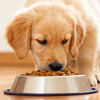How to Train Your Puppy to Eat Dog Food: Nurturing Healthy Habits for a Lifetime
- Houndsy
Table of Contents
- Introduction
- Understanding the Importance of Proper Nutrition
- Common Reasons Puppies Refuse to Eat
- Developing an Effective Training Strategy
- Summary of Key Points
- Conclusion
- FAQ
Introduction
Have you ever watched your puppy sniff at their food bowl and turn away, leaving you wondering what on earth could be wrong? It can be perplexing and even a bit concerning when our furry companions suddenly refuse to eat, especially when we know how essential nutrition is for their growth and health. According to recent surveys, up to 30% of dog owners report having babies with food aversions or pickiness at some point during their training. The good news is, if you're currently facing such a challenge, you're not alone, and there are definitely ways to encourage your puppy to enjoy their meals.
In this blog post, we will delve into effective strategies on how to train your puppy to eat dog food, ensuring they develop healthy and consistent eating habits. We will cover everything from establishing a nutritious diet to minimizing distractions during mealtime, understanding your puppy’s preferences, and addressing potential health concerns.
As devoted pet parents, it’s our responsibility to foster our puppies’ positive relationship with food, making mealtimes both enjoyable and enriching. By the end of this guide, you’ll have a toolkit of practical tips and insights on how to not only get your pup eating dog food but also loving it!
So, grab a cup of coffee, take a seat, and let’s embark on the journey of nurturing a happy and health-conscious pup.
Understanding the Importance of Proper Nutrition
Before we dive into training techniques, let’s take a moment to discuss why proper nutrition is vital for your puppy. Puppies are in a crucial stage of growth, requiring a balanced diet that includes essential nutrients, proteins, vitamins, and minerals to aid their development. Dog foods specially formulated for puppies ensure they receive the right proportions necessary for their bodies to thrive.
Failing to establish a proper diet early on can lead to long-term health issues, including obesity, developmental disorders, and even behavior problems related to food. Therefore, it’s essential not only to train your puppy to eat consistently but to make sure they are consuming quality dog food that meets their nutritional needs.
This is where we at Houndsy come in with our Houndsy Kibble Dispenser. Our product is designed to offer convenient portion control that allows you to serve the exact amount your puppy requires, encouraging consistency in their feeding routine while complementing your modern home decor. You can check out the Houndsy Kibble Dispenser here.
Common Reasons Puppies Refuse to Eat
Understanding the reasons behind your puppy's reluctance to eat can help you devise effective training strategies. Here are some common factors:
1. Distraction by Environment
Puppies are naturally curious and can easily become distracted. New sounds, other pets, or even furniture rearrangements can pull their focus away from their food. Creating a calm, designated feeding area can be essential in helping your pup concentrate on their meal.
2. Preference for Human Food
If your puppy has been spoiled with table scraps or enticing treats, they may start holding out for something they perceive as better than their regular dog food. This behavior can quickly become problematic, requiring a bit of unlearning.
3. Medical Issues
Just like us, puppies can experience health problems that affect their appetite. It's crucial to rule out any underlying health issues, such as dental pain, gastrointestinal problems, or other illnesses. If a puppy suddenly stops eating or shows behavioral changes, a vet visit is advised.
4. Teething
If your puppy is still in the teething stage, discomfort from chewing hard kibble can lead to reluctance to eat. In such cases, consider softening their food with warm water or switching to wet food.
5. Ineffective Feeding Routines
An inconsistent feeding schedule can confuse puppies, leading them to develop picky eating habits. Regular routines along with structured feeding times are crucial for creating a sense of normalcy and expectation around mealtimes.
Developing an Effective Training Strategy
Once you understand the potential reasons for your puppy's food aversion, it's time to implement solutions. Here’s a step-by-step guide on how to train your puppy to eat dog food effectively.
1. Choose the Right Food
Start by ensuring you’ve selected high-quality dog food made specifically for puppies. Puppies have different nutritional needs compared to adult dogs, and food made for seniors or general adult dogs may not meet their growing requirements. Check for ingredients and consider your puppy's preferences while trying out various flavors.
2. Set a Consistent Feeding Schedule
Establish a feeding routine that works for you and your puppy. Puppies thrive on consistency, so aim to feed them at the same times every day. For optimal results, consider scheduling playtime or light exercise leading up to mealtime to help stimulate their appetite.
3. Create a Distraction-Free Zone
Set up a quiet space in your home where your puppy can eat without distractions. This type of environment allows them to focus solely on their meal. Using the Houndsy Kibble Dispenser can also minimize stress for you and your puppy by allowing for an easy and controlled feeding experience.
4. Gradually Transition to New Food
If you’ve recently changed your puppy's food or introduced dry kibble, do it gradually. Mixing the new food with a little of their previous favorite for a few days can ease the transition and help them accept the new flavors and textures.
5. Limit Treats and Human Food
Ensure you're not overfeeding your puppy with treats or human food. If your puppy knows there's a tasty alternative, they may hold out for it. Instead, limit extra snacks and utilize appropriate training treats that complement their dietary needs.
6. Experiment with Textures
Puppies can be particular about the texture of food. If your pup doesn’t seem to enjoy kibble, consider trying wet food or rehydrating their kibble with warm water or low-sodium chicken broth to enhance the aroma and flavor.
7. Employ the Gentle Starvation Method
If your puppy refuses to eat, you can employ a gentle approach. Place their food down for approximately 15-30 minutes, then remove it if they haven’t eaten. This technique encourages them to associate mealtime with positive experiences and hunger.
8. Keep Mealtimes Short and Sweet
Avoid leaving food out for extended periods. Instead, make sure that you provide meals for short intervals. This routine helps punctuate their understanding of mealtime, reinforcing that food is available during specific times.
9. Create Positive Associations with Mealtime
Encourage your puppy to view mealtime as a pleasant experience. Offering praise or a gentle pet while they eat can help reinforce that food is associated with love and comfort.
10. Hand-Feeding as an Approach
If your puppy is particularly hesitant, consider hand-feeding a few kibbles. This one-on-one attention can help them feel more secure during meals, allowing for positive reinforcement. Gradually transition back to bowl feeding once they show a consistent interest in eating.
11. Use Food Toppers and Enhancers
Sometimes your puppy just needs a little boost. You can sprinkle some healthy food toppers or add bits of cooked chicken or vegetables to make the meal more enticing. This tactic can be especially useful when transitioning to a new type of food.
12. Monitor and Adapt
Lastly, consistency is key, but so is adaptability. Keep track of your puppy’s eating habits, preferences, and any changes in their health. If necessary, continually adjust feeding strategies based on your observations and needs.
Summary of Key Points
Training a puppy to eat dog food isn’t an overnight endeavor, but applying a structured approach can cultivate a healthy appreciation for their meals. Creating a consistent schedule, selecting quality food, limiting distractions, reducing treats and employing gradual transitions are all strategic steps to help achieve this objective. Every puppy is different, so it's essential to remain patient and flexible, adjusting your methods as needed to suit your furry friend.
Conclusion
As we wrap up our exploration of how to train your puppy to eat dog food, remember that a healthy, balanced diet is the cornerstone of your pup’s well-being. With patience, understanding, and a commitment to nurturing their growth, we can transform mealtime into a joyful, nourishing experience.
If you’re looking to elevate your feeding routine while embracing modern design, consider investing in the Houndsy Kibble Dispenser. Not only will it help you maintain portion control and reduce mess, but it will also complement your stylish home decor. Discover more about our innovative feeder here.
FAQ
Q: What should I do if my puppy refuses to eat for more than a day? A: If your puppy hasn’t eaten for over 24 hours, it’s essential to consult your veterinarian to rule out any potential health issues.
Q: How can I tell if my puppy is a picky eater? A: If they show a consistent preference for certain foods or refuse to eat altogether after having human food or treats, they may be developing picky eating habits.
Q: Is it okay to mix wet and dry food? A: Yes, mixing wet and dry food can enhance the appeal of meals for your puppy and provide a variety of textures and flavors.
Q: How often should I feed my puppy? A: Puppies typically require three to four meals a day, gradually transitioning to fewer meals as they grow older. Establishing a feeding schedule helps them learn to expect mealtime regularly.
Q: What if my puppy is chewing their food too fast? A: Consider using slow feeder bowls or distributing their food into smaller portions to encourage slower eating.
By following these suggestions and maintaining a consistent approach, we can train our puppies to develop healthy eating habits that last a lifetime. Let’s ensure their first experiences with dog food are positive ones!













